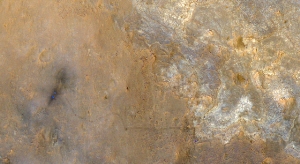Jul 25 2013
An image from NASA's Mars Reconnaissance Orbiter released today shows NASA's Curiosity Mars rover and the wheel tracks from its landing site to the "Glenelg" area where the rover worked for the first half of 2013.
 Image credit: NASA/JPL-Caltech/Univ. of Arizona
Image credit: NASA/JPL-Caltech/Univ. of Arizona
The image is available at http://photojournal.jpl.nasa.gov/catalog/PIA17080 and http://uahirise.org/ESP_032436_1755 .
The orbiter's High Resolution Imaging Science Experiment (HiRISE) camera captured the scene on June 27, 2013, with the orbiter rolled for an eastward-looking angle rather than straight downward. The afternoon sun illuminated the scene from the western sky, so the lighting was nearly behind the camera. This geometry hides shadows and reveals subtle color variations.
Curiosity that day was examining an outcrop called "Shaler," the rover mission's final science target in the Glenelg area before commencing a many-month trek southwestward to an entry point for the lower layers of Mount Sharp. The rover appears as a bright blue spot in the enhanced coloring of the image.
The image shows two scour marks at the Bradbury Landing site where the Mars Science Laboratory mission's skycrane landing system placed Curiosity onto the ground on Aug. 6, 2012, EDT and Universal Time (Aug. 5, PDT). The scour marks are where the landing system's rockets cleared away reddish surface dust. Visible tracks commencing at the landing site show the path the rover traveled eastward to Glenelg.
HiRISE is operated by the University of Arizona, Tucson. The instrument was built by Ball Aerospace & Technologies Corp., Boulder, Colo. NASA's Jet Propulsion Laboratory, a division of the California Institute of Technology, Pasadena, manages the Mars Reconnaissance Orbiter Project and Mars Science Laboratory Project for NASA's Science Mission Directorate, Washington.
For more information about the Mars Reconnaissance Orbiter, visit http://www.nasa.gov/mro . For more information about Curiosity, visit http://www.jpl.nasa.gov/msl , http://www.nasa.gov/msl and http://mars.jpl.nasa.gov/msl .